PDF Creation
PDF is short for Portable Document Format, a file format developed by Adobe Systems. PDF/X is an umbrella term for a series of ISO standards that define subsets of the PDF format specifically tailored for graphics exchange in the printing and publishing industries.
PDF/X standards were developed to address the unique requirements and challenges associated with reliable and consistent graphic reproduction in professional printing workflows. These standards provide guidelines and restrictions to ensure that a PDF/X-compliant file will behave predictably when used for high-quality printing.
PDFs capture formatting information from a variety of desktop publishing applications, making it possible to send documents and have them appear on recipients’ monitors or as print-outs as they were intended to. A PDF file represents an ordered sequence of fixed pages. The planned appearance of everything that each page contains is completely specified, down to the smallest detail. All the text, graphics, and images are specified to appear at precise locations on each page in a particular color, of a given and fixed size. The creator of the PDF file determines the exact appearance that the viewer will see and PDF renderers like Adobe Reader displays the page contents exactly as specified.
In this section, GlobalVision describes best practices regarding the creation of PDF files.
Standardizing PDF/X files
Risk
If PDF/X files are not standardized, processing errors may occur in the proofing and prepress stages.
Issue
The printer may not be able to accurately replicate the originally designed artwork.
Example

Solution
Do
- Standardize your PDF creation method.
- Understand PDF/X standards and choose the ones that align with your specific requirements.
- Embed all fonts and images in the PDF/X file.
- Perform preflight checks using preflight tools to identify and fix any issues in the PDF/X.
Don’t
- Create an encrypted PDF.
- Create PDFs in any application other than Adobe Acrobat.
- Create color-separated PDFs.
- Use low-resolution images.
- Use PDF/X for non-print workflows.
Tips
The following steps may be applied in Adobe Acrobat Pro to save a standard
compliant PDF file:
- Go to the File Menu and click Save As.
- Select PDF/X or PDF/A.
- Type in the file name and click Save.
Ensuring the quality of PDFs using preflight tools
Risk
If preflight tools are not used, processing errors may occur in the proofing and prepress stages.
Issues
What you see on screen is not always what is displayed in print. The printer may not be able to accurately replicate the original artwork.
Example

Solution
Do:
- Include a preflight process in your workflow to ensure the quality control of your artwork files.
- Create and use custom preflight profiles tailored to your specific needs.
- Preflight the artwork in Adobe InDesign before creating the PDF as a precaution to avoid errors.
- Use Adobe Acrobat Pro to preflight PDFs to avoid errors before printing.
Don’t:
- Approve final artwork files without preflighting them first.
- Ignore preflight warnings or errors. Ignoring warnings can lead to print errors or other quality issues.
Tips
The following steps detail how to preflight a PDF in Adobe Acrobat Pro:
- Go to the menu and select View and then Tools.
- In the Tools panel, click on Print Production and select Prefllight.
- Use an existing profile or create one.
- Analyze and make the appropriate changes.
Creating an accessible PDF from a Microsoft Word document
Risk
The reading order in the PDF may not be detected properly if you do not create an accessible PDF from a Microsoft Word document.
Issues
- Poor text formatting.
- Poorly defined data tables due to word-processing incompatibilities.
Example

Solution
Do:
- Use formatting styles and headers in documents.
- Use the bulleted-list feature in Microsoft Word.
- Save as a PDF using an Adobe plug-in.
- Save a tagged PDF.
Don’t:
- Use indentations and bullet points to create lists.
- Use the border and shading option to surround text instead of creating a proper table.
- Use text boxes for critical content as text boxes may not be read in the correct order.
- Use images of text without providing actual text content.
Tips
The following steps detail how to create a tagged PDF in Microsoft Word:
- Go to File and select Print.
- Select Adobe PDF as the printer and click Print to create an Adobe PDF.
Tagging the PDF when styles are applied to text
Risk
If you do not tag the PDF file, styles may not be detected by the proofreading software.
Issue
Differences may not be detected by the proofreading software.
Example

Solution
Do:
- Create a tagged PDF when using different styles to format text (underline, italic, bold, etc.).
- Save the document to retain the accessibility features.
Don’t:
- Leave content untagged, to ensure a meaningful and accessible structure.
- Use preflight profiles tailored to your specific requirements.
- Rely solely on visual formatting, such as bold or italic text, without proper tagging.
Tips
The following steps may be applied to create a tagged PDF in Adobe InDesign:
- Go to File and select Adobe PDF Presets.
- Select the targeted PDF presets.
- Go to the Export PDF Window Options menu.
- Check Create Tagged PDF.
The following steps may be applied to create a tagged PDF in Adobe Acrobat Pro:
- Go to Tools and select Accessibility.
- Add tags to the document.
Always specify the trim box in a PDF
Risk
If you do not specify the trim box in your PDF files, unwanted content in the document may be printed. Leaving the trim box undefined can also lead to unpredictable results in printing or displaying.
Issue
Unwanted content in the document may appear in the final print if the trim box is not specified.
Example

Solution
Do:
- Define the trim and the bleed areas when setting up the document in the design software.
- Always specify the trim box for each page in the PDF.
Don’t:
- Leave the document limited only by the page edge.
Tips
The following steps may be applied in Adobe Acrobat Pro to set the Trim Box
feature in a PDF:
- Go to Print Production and select Tools.
- Set the individual page Boxes.
Ensuring all content in a PDF is accessible
Risk
If all content in your PDF file is not accessible, the proofreading software may not detect all differences.
Issues
- Accessibility in the document may be compromised.
- Text extraction and the reading order may be compromised.
Example
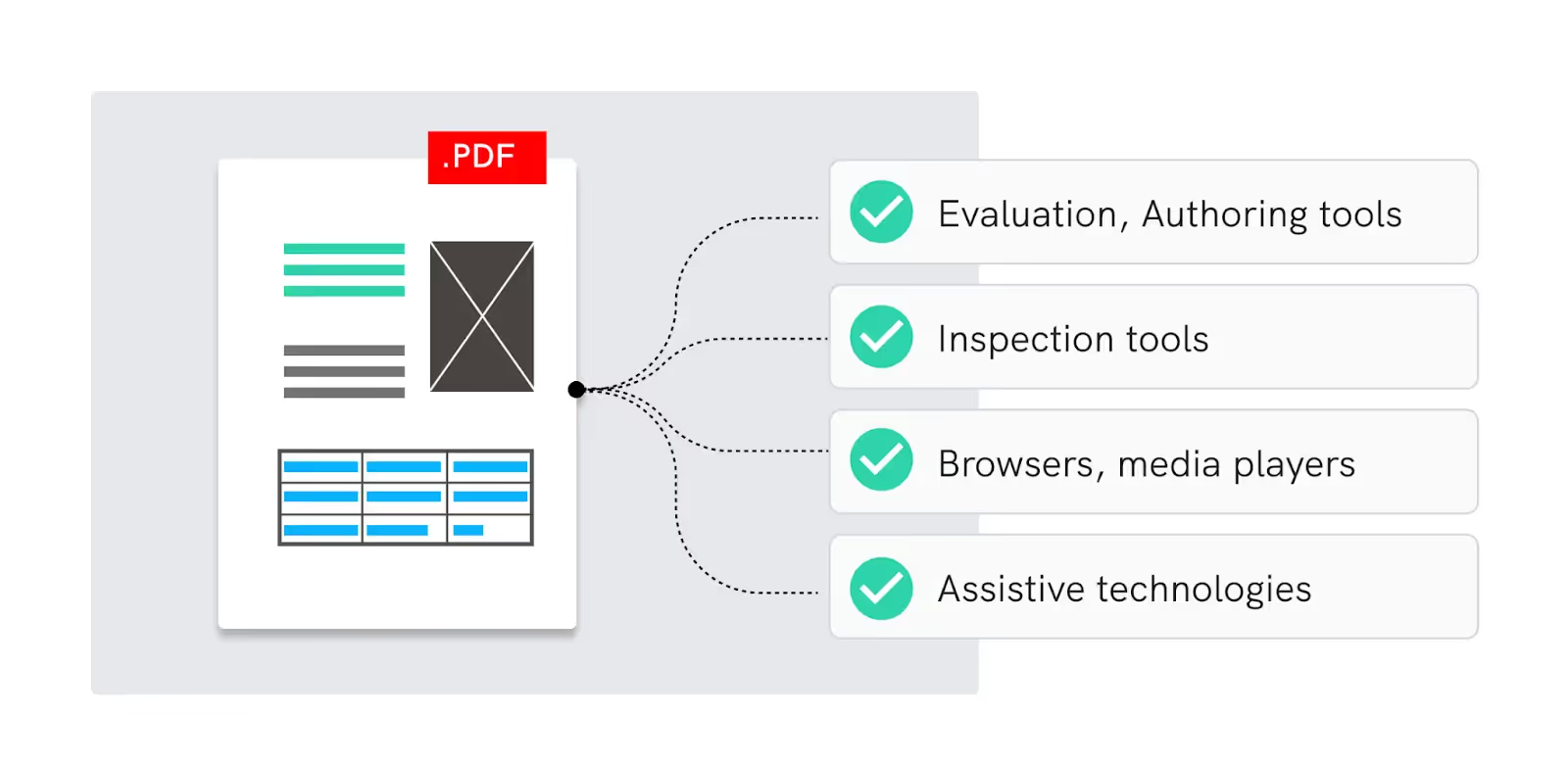
Solution
Do:
- Create searchable text-file documents (live text).
- Use tags to indicate the structural elements of the documents.
- Use a clear and easy-to-follow reading order.
- Specify the text language.
- Use fonts that allow characters to be extracted to text.
Don’t:
- Use outlined text in the PDF.
- Restrict users from printing, copying, extracting, or editing text by using security settings.
Tips
The following steps may be applied to check the accessibility in an Adobe
Acrobat Pro PDF file and help evaluate and identify areas that may conflict with
accessibility guidelines:
- Go to Tools and select Accessibility.
- Select Full Check.
- Verify the Accessibility Report.
Standardizing PDF producers to create PDFs
Risk
If you do not standardize on a PDF producer, poor quality PDF files may be created along with PDF files with accessibility issues.
Issues
- Different PDF producers create PDF files of varying quality.
- Older PDF producers may create PDF files using low quality settings.
- Results may differ from one PDF version to another.
Example

Solution
Do:
- Use the latest version of Adobe Acrobat Pro to create PDFs.
- Upgrade your Adobe Creative Suite on a regular basis.
- Standardize the PDF Version being used to create files.
- Prioritize PDF producers that support the creation of accessible PDFs.
Don’t:
- Use old technology PDF producers.
- Create PDFs in outdated Versions of Adobe Acrobat.
Tips
Please refer to the following appendices for details on which PDF producer to
standardize on:
- Appendix 01 PDF Compatibility Levels.
- Appendix 02 PDF/X Comparison.
Avoiding duplicate text frames within extra hidden content
Risk
Unwanted content will be detected in the final approved material PDF.
Issues
- Duplicated text may be detected by the proofreading software.
- Text overrides in the final PDF.
Example

Solution
Do:
- Only place needed content into the text frames.
- Import content directly from a Word doc.
Don’t:
- Place content PDF into the text frame with extra text.
- Mask the extra content from the PDF.
- Truncate text frame.
Tips
Use the Preflight panel: InDesign has a Preflight panel that can help you identify potential issues in your document including over-set text, missing links, and other problems.
Using a dieline in a separate layer and in a unique color
Risk
If you do not use dielines in a separate layer and in unique colors, valid content may not be detected when used in a dieline layer.
Issue
Valid content that disappears when using the dieline layer will be used to mask the area surrounding the label or package.
Example

Solution
Do:
•Use the dieline only in a unique layer.
•Apply a unique color to the dieline.
•Use a different color to design a crease.
•Standardize the layer names through comprehensive naming (dieline, crease, etc.).
Don’t:
•Mix the valid content within the dieline layer.
•Use the dieline color for any other object in the document.
Tips
The following steps describe how to view information when creating a PDF with layers in InDesign and Illustrator:
- Export to PDF.
- Choose the PDF Preset.
- Make sure to check the “Create Acrobat Layers Top-Level Layers”.
- The layers compatibility is updated (i.e. you are using an updated version of Adobe).
Ensuring layers and separations do not affect each other when one is disabled
Risk
If you do not ensure layer and separations do not affect each other when disabled, valid content will not be detected when included in inactive layers.
Issue
When hiding one layer such as the die cut or varnish, other valid content will also be disabled and therefore won’t be able to be inspected in a proofreading software.
Example
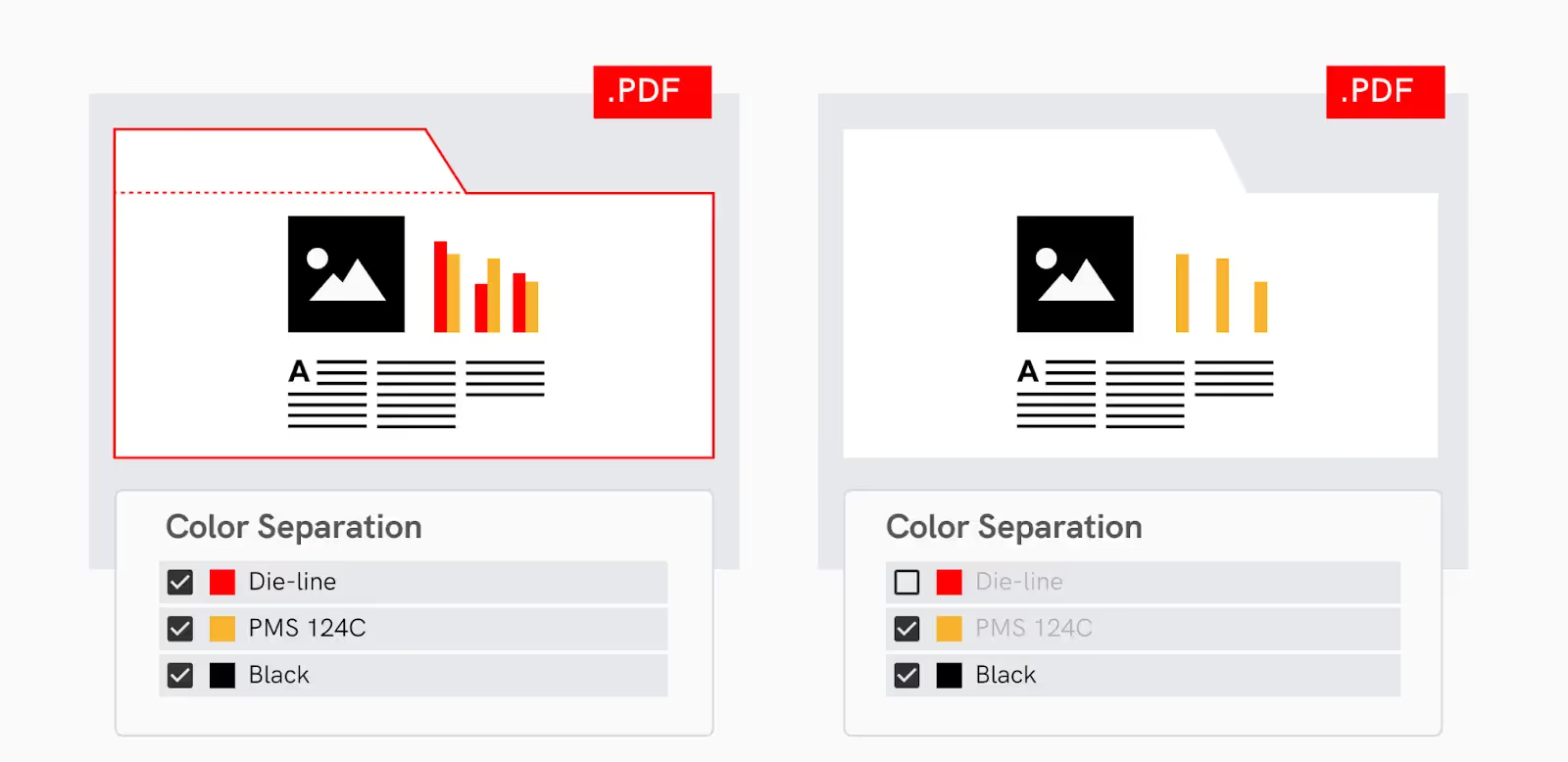
Solution
Do:
• Use valid content in separate layers.
• Standardize the names to simple and clear names.
• Use the dieline as a unique layer.
Don’t:
• Mix content with dieline or information layers.
• Use the same value color of the dieline and varnish invalid contents.
Tips
The following steps describe how to view information when creating a PDF with layers:
InDesign and Illustrator:
- Export to PDF.
- Choose the PDF Preset.
- Make Sure to Check the “Create Acrobat Layers Top-Level Layers”.
- The layers compatibility is updated (i.e. you are using an updated version of Adobe).
Overprinting that only affects the planned overprint object
Risk
If you do not ensure your overprint only affects the planned overprint object, valid content will not be detected when applied to a no-planned overprint.
Issues
When turning overprint on, other valid content is also disabled and hence cannot be inspected.
Example
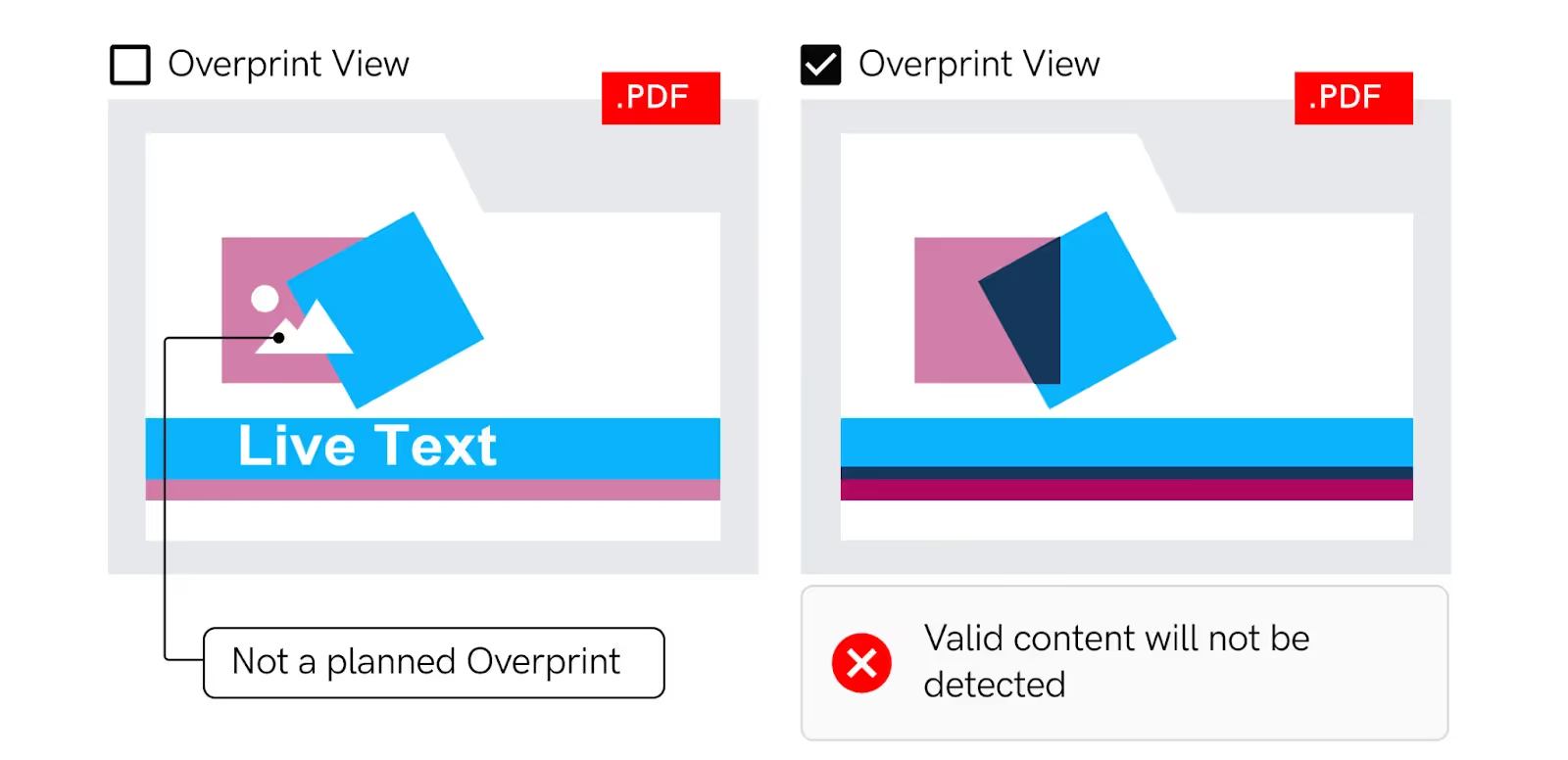
Solution
Do:
- Get your overprint settings just right.
- Standardize the names to simple and clear names.
- Use dieline in a unique layer.
Don’t:
- Mix content with dieline or information layers.
- Use the same color value of the dieline for the varnish invalid contents.
Tips
The following steps describe how to view information about an Overprint in the PDF in.
In Adobe Acrobat:
- Go to Tools.
- Click Print Production.
- Choose "Output Preview" after opening this tool.
- Change your preview to "Color Warnings".
- Then check the box "Show Overprinting".
Avoiding generating a bitmap PDF
Risk
If you generate a bitmap PDF, missing elements will be detected in the PDF during the inspection.
Issues
- A PDF that is fully loaded into the proofreading software may detect missing elements of inaccessibility to a part of the PDF.
- Cannot contain other content such as searchable text.
Example
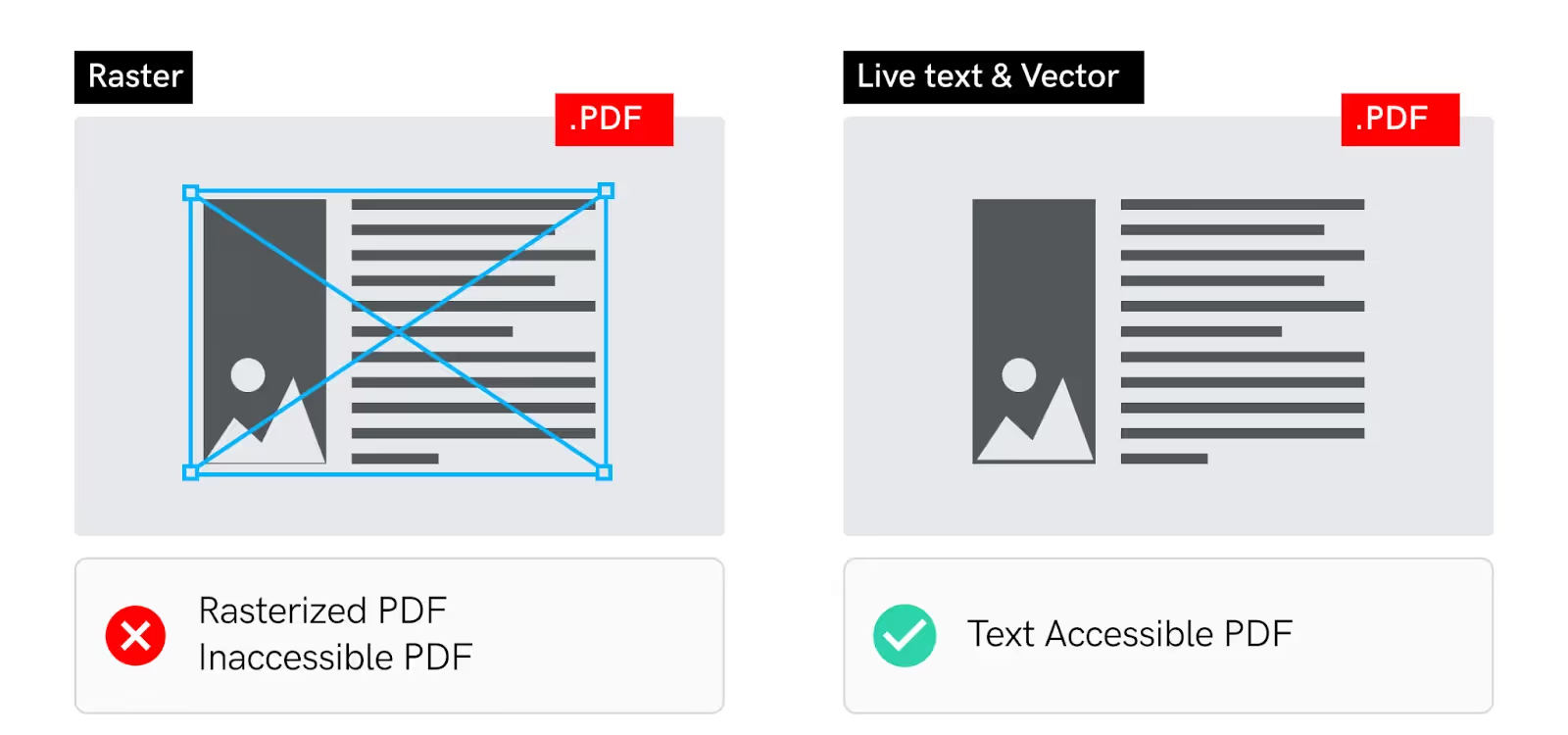
Solution
Do:
- Keep all text live for accessibility.
- Save the final PDF that is layered and editable in Adobe Illustrator.
- Embed fonts in the PDF to ensure that the document appears as intended in other systems.
Don’t:
- Turn the PDF into a bitmap PDF.
- Create an outline of the text in the PDF.
- Use Low-Resolution images.
Tips
The following steps describe how to view information about live text in a PDF in Adobe Acrobat:
- From the Menu Bar, go to Edit.
- Select PDF Content.
- Select All Text.
- All text in the PDF should be highlighted in blue. If the characters aren’t highlighted, they are either a raster or vector image.
Using the original PDF not a flattened copy of the PDF
Risk
Using a PDF file with flattened layers instead of the original file reduces the usability of a PDF.
Issue
PDFs with flattened layers make it much harder to extract contents.
Example

Solution
Do:
- Create a PDF with layers.
- Keep all text live for accessibility.
- Standardize the layer names (e.g. Dielines, Artwork, Braille, Barcodes, etc.).
Don’t:
- Flatten layers.
- Create PDFs in outdated versions of Adobe Acrobat such as versions 1.4 and lower.
Tips
The following steps describe how to view information about creating a PDF with layers.
InDesign and Illustrator:
- Go to Export to PDF.
- Choose the PDF Preset.
- Make sure to check the “Create Acrobat Layers Top-Level Layers”.
- Standardize on a newer PDF compatibility version.
Avoiding duplicate frames with extra content in the layout
Risk
If you use duplicate frames, it will lead to unwanted content being detected in the final approved material PDF.
Issues
Duplicated text may be detected by the proofreading software.
Example
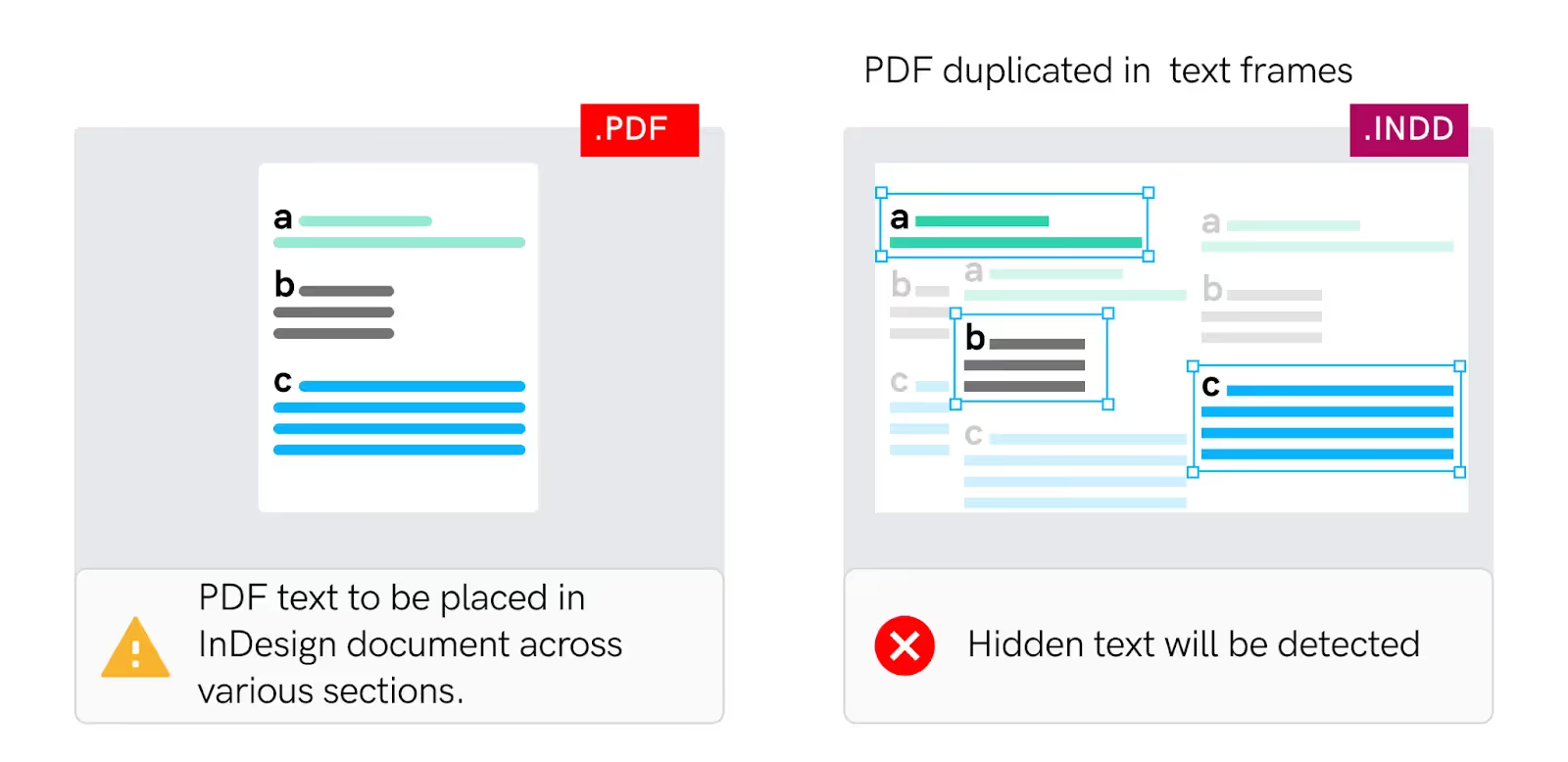
Solution
Do:
• Place only needed content in the text frames.
• Import content directly from a Word document.
Don’t:
• Place content PDF in the text frame with extra text.
• Mask the extra content from the PDF.
Tips
The following steps describe how to view information about a given font when
using Apple Font Book on a Mac system:
- Select a font by clicking on it.
- Click on the "Info button" to open the Information Panel.
- In the Information Panel, explore sections like "Languages," "Usage," "Identifiers," and more to access detailed information about the selected font.
Avoiding combining multiple PDFs into one
Risk
If you combine multiple PDF files into one, it can compromise the layer separation handling.
Issues
- A combined PDF, displaying all layers at once with a jumping page when turning OFF layers.
- Combined PDFs handle PDF layers badly.
- Combined PDFs display layers with the same name as the file.
Example

Solution
Do:
- Generate a multipage PDF directly from InDesign.
Don’t:
- Combine multiple PDFs into one PDF.
- Create PDFs directly by importing different files.
Tips
- Inspect each PDF file individually using a multi-file inspection feature as a process


